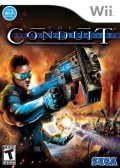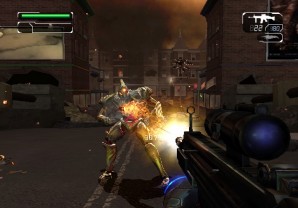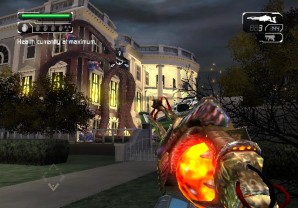Interview: High Voltage on The Conduit

High Voltage Software was founded back in 1993, and since then their output has largely consisted of licensed and child-orientated titles. Although working on those games may not have gained them a huge amount of critical acclaim, it’s clear that this type of work was financially beneficial, as development of The Conduit has been entirely self-funded by the developers.
 SEGA only signed on to publish The Conduit relatively recently, and it’s at the home of the blue hedgehog that we got the chance to sit down and have a chat with one of the developers.
SEGA only signed on to publish The Conduit relatively recently, and it’s at the home of the blue hedgehog that we got the chance to sit down and have a chat with one of the developers.
DarkZero: If we could begin with you telling us who you are, and what role you play in the creation of The Conduit.
Developer: My name is Eric Nofsinger, and I’m the Chief Creative Officer at High Voltage Software. My role in this project is as the Head of Product Development. So, I make sure that the product is high quality and I’m in charge of overseeing all of the various departments.
DZ: What was your main focus on The Conduit? What one thing did you want to ensure was done right, more than anything else?
EN: I think really what we were trying to do as far as a singular item, was just to make sure that the game was fun. That’s such a subjective and probably a lame cop-out answer, but gameplay is king. I mean, yes we want the game to be graphically compelling and superior to any other Wii product available. Yes, we wanted to make sure that the title is satisfying to core gamers and that we could deliver on customisation and control and depth and variety etc. Yes, we wanted to reach out to mainstream folks and maybe pull in a new type of fan that maybe hasn’t played a first-person shooter before. And we made a lot of cognisant decisions to take those things in account as well. But more than anything it really was about fun. We wanted this game to be something that we would play and be satisfied with as gamers.
DZ: What do you feel the greatest benefits were of developing The Conduit on the Wii as opposed to the other available consoles?
EN: The control mechanism. The IR device and the fact that the Wii Remote allows the player to point directly at the screen, and use motion control for both the Wii Remote and Nunchuk. It’s an exciting design opportunity that isn’t afforded on other devices. I don’t think that the PS3’s SixAxis controller is even in the same universe as an input device. Also, now it affords us 50 million potential consumers, which is a nice perk as well! But that’s really something that happened along the way, it wasn’t the motive of developing for the Wii. We were motivated by the fact that we had a new way to input, and that was very exciting.
DZ: Was it a challenge to get the controls to feel right for everyone? Or did the extreme customisability make things easy?
EN: It was challenging, however we made that our first priority. All of us at the studio feel that controls need to be very good. Controls, input and camera – these are all things that if you don’t them nail right on any sort of game, it can completely wreck the rest of it. If you don’t have those done right first, then you’re just tacking things on. You can try to fix it with features and bullet-points but your core gameplay is never going to feel right. So that was the first challenge that we tackled, and there were a lot of iterations. Fortunately we developed some tools that allowed us to very rapidly iterate that.
Then, it only made sense to open it up to consumers. Within the team, we had default control settings that felt very good, and we tried to make those accessible for different types of gamers. But beyond that, even within the team we had people who wanted different options. Some people would say, “I don’t jump around a lot, so instead of having jump assigned to the A button, I’d prefer that button to be a melee attack.” Or “I use melee but I don’t want that to be controlled with a motion, I’d rather put that on the d-pad so I don’t have any camera disorientation.”
But by opening that up, it was a bit of a Pandora’s Box though, because after that we opened up all kinds of things. We allowed the player to modify their bounding box, their dead zone, their turning speed, their cursor sensitivity, their camera look angle, and the options just went on and on. And we thought, well if we’re going to do all this, then let’s allow them to change it in real-time, because we want this to be done in-game rather than going through a menu and having to keep hopping back into the game to keep trying different things out. And that worked out nicely because you can rapidly determine what works right for you.
Then one of our UI artists had the idea, why don’t we make the HUD customisable too? We’re doing all this other customisation and HUD is such a big component of the game. So now you can drag and drop any HUD elements to wherever you want, make them more or less translucent, or even turn them off. If you’re a really hardcore player, you could reduce your bounding box to two pixels wide, crank your turning speed through the roof, and turn your HUD off, then those options are there for you. And I guarantee it will be as sensitive as you could ever want, you’d barely move and you’ll be flying all over the place. I wouldn’t recommend standing behind and watching it though, you might get a bit motion sick.
DZ: Was an online component something that you’d planned from the start, or was that a secondary concern after a single player campaign?
EN: Online came about very quickly during our pre-production. The team sat down and thought, what are key pillars that a definitive first-person shooter needs to have? Online came up right away. Metroid Prime is a great first-person perspective game, but it’s really more of an adventure game in its mechanics, and it has no online component. So while it’s a great game, it’s not really a first-person shooter. And the other games available on the Wii were crap. As far as first-person shooters go, when you’re looking down the list they’re either ports or poor quality titles that don’t take advantage of the technical and graphical capabilities of the console. So we looked at the system and the genre and figured out what was most important for both. That really gave us marching orders for the whole project.
DZ: Why do you think that other developers haven’t managed to create a Wii game like The Conduit, that is comparable to titles on ‘next-generation’ systems?
EN: Every developer and publisher has their own reasons, but one of the more pervasive ones is that there is an argument in the industry right now that Wii consumers don’t really want games like this. I think that argument is cyclical and false. There’s not really many products like this to purchase on the Wii, and if all there is to buy is casual and party games, then of course those will be the games that appear to be selling the most, when there aren’t high quality products for core gamers available. There have been some attempts at core-type games but some of those have not been very accessible. So although these games are may be very good and critically-acclaimed they’ve not tried to be mainstream in their approach. I mean aesthetically, some have taken very extreme and stylistically interesting approaches, but that can be off-putting to a larger audience.
Also some of those games thematically are not covering big, commonplace themes – we’ve taken a more Hollywood, popcorn blockbuster direction with The Conduit. We wanted to create something that could appeal to the core, but could also have an appeal for Wii owners in general. I hope that our game is going to change things, I hope that we do have imitators, I hope that we set a new standard for showcasing the graphical and technical capabilities of the system. But that will only happen if people get out there and buy it!
DZ: Let’s hope they do. From what I’m played of The Conduit, I’ve noticed several elements that seemed to be inspired by other hit games such as Halo 3. Would you say that was a game that you looked towards for inspiration?
EN: For sure, absolutely. We looked at a lot of different shooters. We certainly looked a lot at Perfect Dark, GoldenEye, the Halo series and Resistance: Fall of Man, and would I think that all of those influences are pretty transparent when playing the game. We’re not shy about looking at games that are very good and saying, those games meant something to us, how can we make this our own? And if people talk about The Conduit in the company of those games, then I couldn’t be prouder.
DZ: Did you require or receive much input from Nintendo to add support for features like the Wii Speak peripheral? (The Conduit will be the first third-party Wii game to use Wii Speak).
EN: Yes, we needed lots of input and support! Nintendo were awesome, they were very gracious. We had communication with their engineers and that’s the tricky part about doing something that hasn’t done before. When we decided to support Wii Speak, there wasn’t a game out yet with that feature. We had the early prototypes, Animal Crossing wasn’t released yet, they were still developing a lot of the software and deciding exactly how it would work. It was challenging, but it was also very rewarding and I think it worked out well. I’m proud of what we were able to get out of it, and I think what we’ve done with Wii Speak definitely moves what Animal Crossing did up a few notches.
DZ: You decided not to use the Wii MotionPlus expansion on The Conduit in the end. Do you think that device could add anything to a first-person shooter on the Wii? Or does that genre not require the extra level of sensitivity?
EN: We think Wii MotionPlus is a really neat device, and as soon as we found out about it we had planned to support it. We got early hardware prototypes, but at that point we were very far down the road of development. We tried to incorporate it exactly how we had planned to, but it just didn’t work out quite well for us. It was definitely more useful for melee-based combat than for ranged, and we didn’t see any significant benefit.
It would have felt like a lie to customers to have just an extra bullet-point on the box just to sell a few more units, and end up with players getting frustrated. I, as a consumer, would have been very mad if I bought a device specifically for a certain game, and didn’t see a significant difference.
Having said that, we did scramble the troops and tried to incorporate additional melee weapons. We’ve got a basic melee attack but had never really planned on having a lot of melee weapons in The Conduit. We did try out some melee weapons which showed a lot of promise, actually some of them were quite fun, but at the time we were doing that we realised that we didn’t have enough time left in development to really polish them, and then balance them back in with the rest of the game that we had spent a lot of time balancing. So it was too risky, and we decided to leave that on the table for future games.
So, to answer that second part of that question – yes, I think there is a place in first-person shooters for Wii MotionPlus, I just think the game really needs to be designed for that device from the ground-up. If you tack it on at the end, you’ll end up doing what a lot of other developers are doing with their Wii games overall, which is just taking a PS2 or PSP game and porting it over and expecting it to be great, and it’s not…
DZ: I think we’ve all played a few too many of those… So, if someone asked you for a single advantage that The Conduit has over other titles, what would it be?
EN: If I had to pick just one feature, at the risk of sounding like a broken record, I’d say it’s the controls. I’d encourage anyone to try out our game and within a few minutes they should be able to feel completely at home with the controls. And if it doesn’t feel comfortable to you, then just by rapidly tweaking a few options you can get the controls feeling exactly right for your own movements. After the past twenty months of developing this game, I can say it’s become very difficult for myself and other members of the team to go back and play other shooters, even on other platforms, and there some great shooters that have come out too! It just kinda feels like you’re washing your clothes on rocks after that, and as much as I love other consoles for shooters, I feel that the Wii Remote as an input device is far superior to analog sticks.
DZ: So do you feel that The Conduit has raised the bar for controls on the Wii?
EN: I think we’ve raised the bar for controls on the Wii, and also for customisation, graphical fidelity, online play, and for really listening to the Nintendo community and gamers in general. Many of the features and the technical and graphical improvements that we included in the game are directly due to fans, forum comments and trade shows. We’re definitely a developer that when we got to the point where we could incorporate all that feedback, I and other team members would actively go to events with notebooks. When people would say something we would write it down and literally go straight back to the rest of the team and put it on our ‘To Do’ list, and incorporate it into the game. It felt like a very inclusive way of developing, as opposed to developing in a vacuum, then throwing it all out there and saying “Here, you’ll like our game.” It feels as much like we made this game with the community, as making it for ourselves.
I think The Conduit will raise the bar on many fronts on the Wii, and I hope at E3 other upcoming trade shows, that I’ll see a lot more competition for us. But we’ve got a few other tricks up our sleeves.
DZ: Leading onto the next question, do you have any more plans once the game is shipped?
EN: We do. There are many, many things that we wanted to do, but just didn’t have time for. And subsequently, we’ve played around with them and I think they’d be really good. We’ve also continued to develop our engine technology, there were many advancements that we made there, technically and graphically, that would have been great to implement, but again we ran out of time.
We’ve started development on some other original things that I think consumers will be pretty impressed with. I’m looking forward at this E3 to being able to announce several new things that we’re working on that I think will raise our own bar.
DZ: Would those be in the same sort of vein as The Conduit?
EN: You’ll just have to wait and see… But one of those certainly has some elements of The Conduit, and both games build off the strength of the technology that we have. In both instances these are games that put The Conduit’s graphical and technical advancements to true use. We’ve learned a lot from making The Conduit, and we have a lot of stuff now that we can implement from the start, as opposed to this time a lot of this stuff we were building and creating as we went along. So now it’s great, going in from the beginning and knowing that we can do all this stuff, and that we’ve made other advances that we can incorporate too. I think the Wii’s still got a lot of juice left in it that we can squeeze out.
DZ: So can we take from this that you’re intending to keep developing on the Wii to build upon what you’ve done?
EN: Yeah, we love the Wii, and there are 50 million other people out there who seem to love it as well.
DZ: Thanks a lot for your time
The Conduit will be released in the UK and Europe on 26th June.





